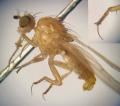Diptera.info :: Identification queries :: Diptera (adults)
|
Cranefly behavour
|
|
| Graeme Cocks |
Posted on 09-10-2013 00:59
|
|
Member Location: Townsville, Australia Posts: 3083 Joined: 09.09.08 |
These Craneflies where observed by David Rentz (his picture also). They were attached to each other by their tarsi and blowing in the wind. Photography was very difficult under these condition. There were 20 flies in this chain, and other chains could be seen blowing in the wind. Has any one observed this behavior? The location was on the Marrdja Boardwalk, Cape Tribulation, North Queensland, Australia. Graeme Cocks attached the following image:  [53.57Kb] Edited by Graeme Cocks on 09-10-2013 01:01 |
| Graeme Cocks |
Posted on 09-10-2013 01:01
|
|
Member Location: Townsville, Australia Posts: 3083 Joined: 09.09.08 |
Second try for the pic. |
| John Carr |
Posted on 09-10-2013 01:43
|
|
Super Administrator Location: Colorado, USA Posts: 10537 Joined: 22.10.10 |
Interesting. The picture reminded me of a common American fly that has white tarsi and drifts on the wind, but it belongs to a family not found in Australia. According to Stephen Marshall's big book of flies, some Limoniinae hang on spider webs. So do many Cecidomyiidae. |
| Graeme Cocks |
Posted on 09-10-2013 06:49
|
|
Member Location: Townsville, Australia Posts: 3083 Joined: 09.09.08 |
It's been suggested to me that the flies are all holding onto the same spider web thread. Hence forming a chain. Which I think is what John Carr is suggesting.
Edited by Graeme Cocks on 09-10-2013 06:51 |
| Paul Beuk |
Posted on 09-10-2013 07:16
|
|
Super Administrator Location: Netherlands Posts: 19403 Joined: 11.05.04 |
Different midges, similar behaviour: http://www.dipter...ticle_id=1.
Paul - - - - Paul Beuk on https://diptera.info |
| Graeme Cocks |
Posted on 09-10-2013 07:24
|
|
Member Location: Townsville, Australia Posts: 3083 Joined: 09.09.08 |
Thanks Paul and John. Mystery solved. |
| jfarr |
Posted on 02-03-2020 15:46
|
|
Member Location: Posts: 46 Joined: 14.01.20 |
I have seen crane-flies(limonia)swarm over salt marsh grass and form very tight formations.(Usually just after they emerged from pupae).some could be caught by spider webs.There are many predators of Crane-flies when they emerge in Spring and late Summer.
Edited by jfarr on 04-03-2020 15:40 |
| Jump to Forum: |













